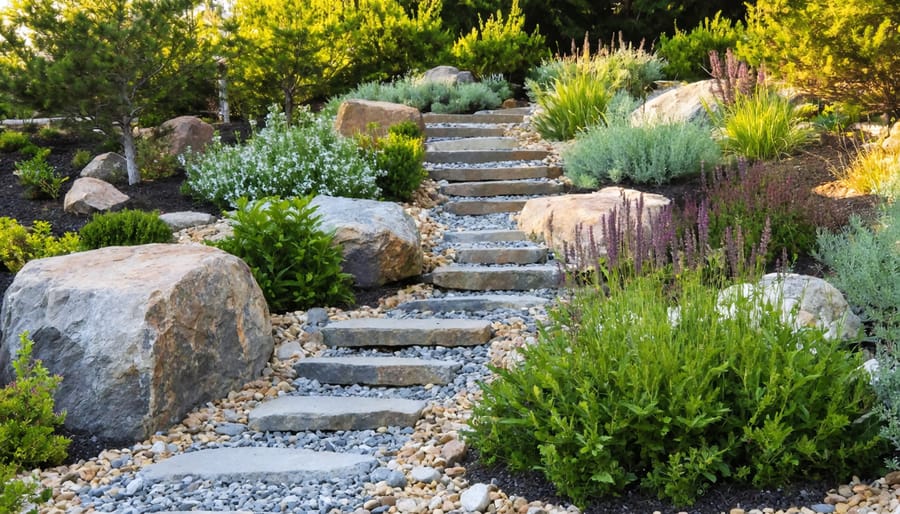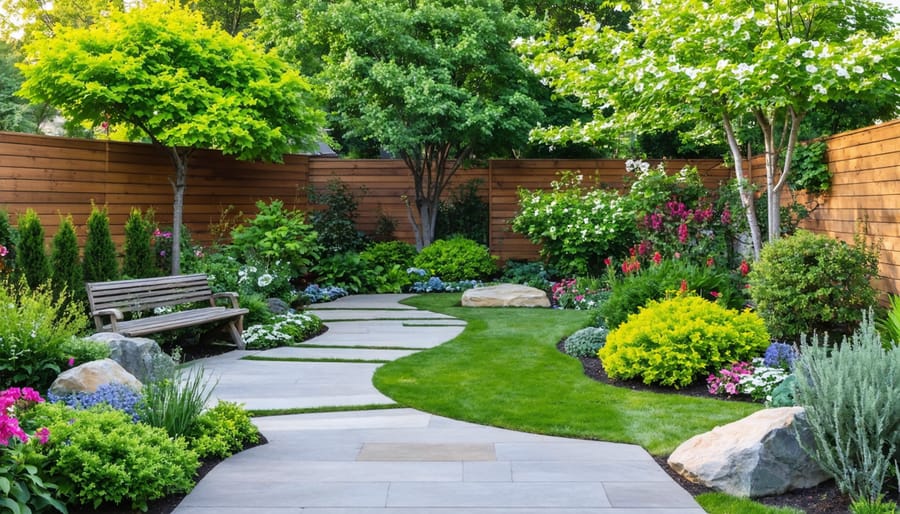Transform your backyard dreams into a thriving vegetable garden by starting your garden from scratch with strategic planning. Map your garden’s layout on graph paper, marking sunlight patterns and existing structures to maximize growing space. Position tall plants like tomatoes and pole beans along the north side to prevent shading shorter crops. Create raised beds in 4×8-foot sections, allowing 18-inch pathways between them for easy maintenance and harvest. Group vegetables by water needs and growth cycles – placing heavy feeders like squash separate from light feeders like herbs. This thoughtful approach to garden planning not only boosts yields but also simplifies seasonal maintenance, making your vegetable garden both productive and enjoyable throughout the growing season.
Site Selection and Garden Layout
Finding Your Garden’s Sweet Spot
Success in vegetable gardening starts with finding the perfect location, and following these beginner gardening steps will help you identify your garden’s sweet spot. First, observe your yard throughout the day to track sunlight patterns. Most vegetables need 6-8 hours of direct sunlight to thrive, so look for areas that receive ample morning and afternoon sun.
Next, check your soil’s drainage by digging a 12-inch hole and filling it with water. If it takes more than 24 hours to drain, you’ll need to improve drainage or consider raised beds. The perfect spot should also have easy access to a water source – lugging heavy watering cans across your yard can quickly become discouraging!
Consider convenience when choosing your location. Place your garden where you’ll see it daily, perhaps from your kitchen window or along a frequently used path. This visibility helps you spot potential problems early and makes harvesting more convenient.
Don’t forget to account for natural elements like wind exposure and shade from buildings or trees. A bit of protection from harsh winds can benefit your plants, but too much shade from nearby structures might limit your growing options. Remember, you can always modify less-than-perfect conditions with structures like trellises or windbreaks, but starting with the best possible location will set you up for gardening success.
Smart Layout Strategies
The key to a productive vegetable garden lies in smart bed configuration and thoughtful spacing. Square foot gardening has revolutionized small-space growing by dividing beds into 1-foot squares, allowing you to maximize every inch. For beginners, 4×4 foot raised beds are ideal, providing easy access from all sides while keeping maintenance manageable.
Consider implementing wide-row planting, where vegetables are grown in bands rather than single rows. This method not only maximizes space but also reduces weeding and creates a living mulch as plants mature. For vertical gardening enthusiasts, installing trellises along north-facing edges prevents taller plants from shading shorter ones.
When it comes to spacing, remember the “three sisters” method – an ancient Native American technique of planting corn, beans, and squash together. The corn provides support for climbing beans, while squash spreads along the ground, suppressing weeds and retaining moisture.
For continuous harvests, try the block rotation method: divide your garden into four sections and rotate crops annually. This practice helps prevent soil depletion and reduces pest problems. Leave 18-24 inch pathways between beds for comfortable access with tools and wheelbarrows.
Remember to group plants with similar water and sunlight needs together. This strategic placement makes maintenance easier and ensures all plants thrive in their optimal conditions. For small spaces, consider keyhole gardens – circular raised beds with a center compost area that provides nutrients and reduces watering needs.
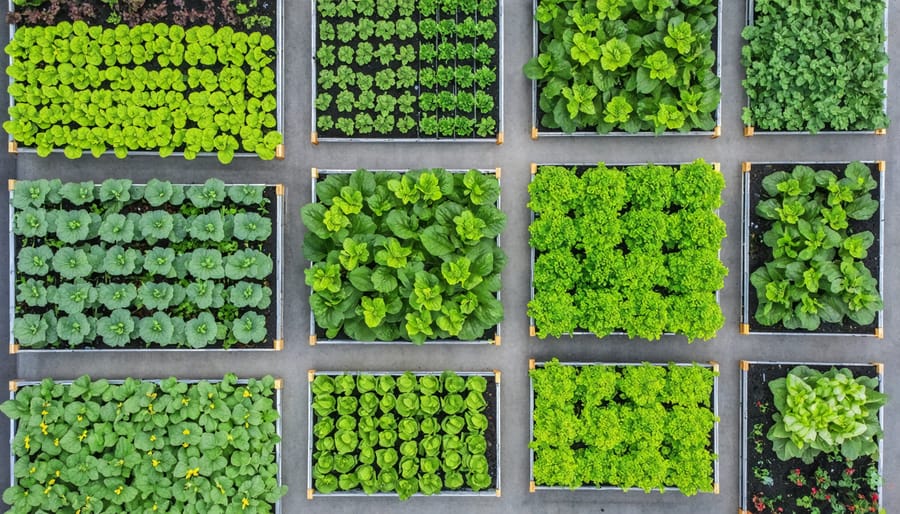
Companion Planting and Crop Rotation
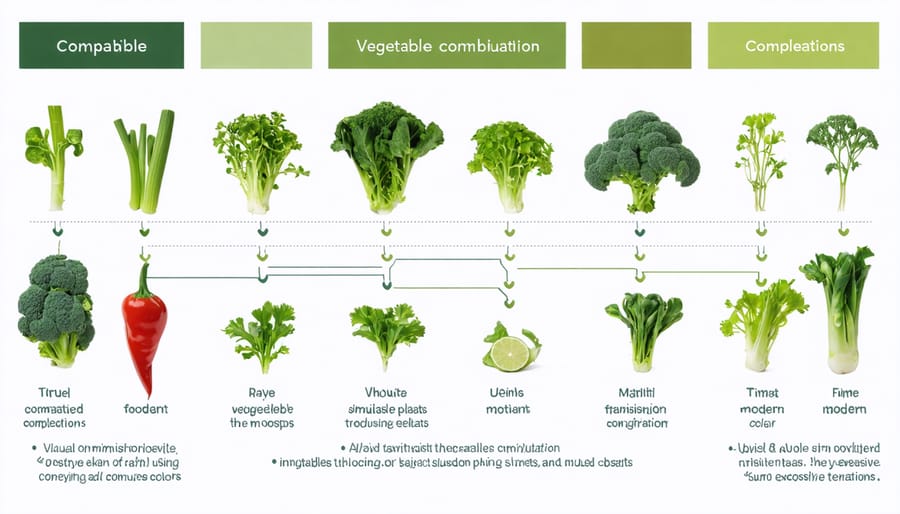
Perfect Plant Partners
Just like good neighbors, certain vegetables thrive when planted together, creating beneficial partnerships in your garden. Tomatoes and basil are classic companions – the basil enhances tomato flavor while deterring pests. Plant them 18 inches apart, with basil serving as a fragrant undergrowth.
Tall, climbing peas or beans work wonderfully alongside carrots. The legumes fix nitrogen in the soil, benefiting the carrots below, while their vertical growth maximizes garden space. Space these partners about 4-6 inches apart, with climbing supports for the legumes.
The “Three Sisters” planting method – corn, beans, and squash – is a time-tested combination. Corn provides support for beans, which add nitrogen to the soil, while squash spreads along the ground, suppressing weeds and retaining moisture. Allow 4 feet between each grouping for optimal growth.
Lettuce appreciates the shade of taller plants like peppers or eggplants during hot summer days. Plant lettuce 6 inches apart in the shadier spots created by these sun-loving vegetables. Another winning combination is onions or garlic planted around the edges of your cabbage patch – they help deter cabbage moths and other pests.
Remember to consider mature plant sizes when planning these partnerships, and always ensure each plant has adequate space to reach its full potential.
Year-Round Success with Rotation
Crop rotation is one of the most powerful tools in a vegetable gardener’s arsenal, helping maintain soil health and maximize harvests throughout the year. By moving plant families to different locations each season, you’re creating a natural defense against pests and diseases while balancing soil nutrients.
Start by dividing your garden into at least four sections. Group vegetables by their families: nightshades (tomatoes, peppers, eggplants), legumes (peas, beans), brassicas (cabbage, broccoli, kale), and root crops (carrots, beets, onions). Each family has different nutrient needs and affects the soil differently.
Here’s a simple rotation pattern to follow: After growing heavy feeders like tomatoes, plant nitrogen-fixing legumes in that space the following season. Follow legumes with leafy greens, which benefit from the nitrogen left behind. Finally, plant root vegetables, which prefer soil that isn’t freshly fertilized.
Keep a garden journal to track what grows where each season. This not only helps you maintain your rotation schedule but also allows you to note which combinations worked best in your garden. Remember that even small gardens can benefit from rotation – you can scale this principle to any size plot.
By practicing crop rotation, you’ll notice fewer pest problems, healthier plants, and better yields year after year. It’s nature’s way of keeping your garden in perfect balance.
Seasonal Planning Calendar
Spring and Summer Planning
As temperatures rise and frost risks fade, it’s time to plan your warm-season crops. Start by mapping out your garden space for heat-loving vegetables like tomatoes, peppers, and cucumbers. These crops thrive when soil temperatures consistently stay above 60°F (15.5°C), typically from late spring through summer.
Create a planting schedule that staggers your crops. For example, plant bush beans every two weeks for continuous harvests throughout the season. Consider companion planting combinations, such as basil near tomatoes or marigolds throughout the garden, to naturally deter pests and enhance growth.
Don’t forget to plan for vertical growing spaces. Trellises and supports for climbing vegetables like pole beans and cucumbers should be installed before planting to avoid disturbing roots later. This approach maximizes your garden space and keeps fruits clean and accessible.
Water management becomes crucial during warm months. Consider installing a drip irrigation system or soaker hoses early in the season. Mulching around plants helps retain moisture and suppress weeds, which can be especially aggressive during summer months.
For fall harvests, remember to start your second round of cool-season crops like lettuce and spinach in late summer, using shade cloth or taller plants to protect seedlings from intense heat.
Fall and Winter Strategy
Don’t let your gardening enthusiasm hibernate during the cooler months! Fall and winter can be surprisingly productive seasons for vegetable gardening with the right strategy. Cool-season crops like kale, spinach, Brussels sprouts, and carrots actually thrive in lower temperatures, often developing sweeter flavors after light frosts.
To extend your growing season, consider using season extenders such as cold frames, row covers, or hoop houses. These protective structures create mini-greenhouses that shield your plants from harsh weather while allowing sunlight to penetrate. Start by planting your fall crops in late summer, timing them to mature just as temperatures begin to drop.
Winter-hardy varieties deserve special attention in your planning. Garlic planted in fall will establish roots before winter and emerge strong in spring. Root vegetables like parsnips and turnips can stay in the ground throughout winter, protected by a thick layer of mulch.
For successful winter harvests, focus on proper timing and protection. Consider succession planting of quick-growing crops like lettuce and radishes every two weeks during fall. Remember to water less frequently but deeply, as soil tends to retain moisture longer in cooler weather. With these strategies, you can enjoy fresh homegrown vegetables well into the winter months.
Space-Saving Solutions
Vertical Growing Techniques
Growing vertically is a game-changer for small gardens and maximizes your growing space beautifully. By training plants to grow upward instead of outward, you can double or even triple your garden’s productivity while creating an eye-catching display.
Start with sturdy trellises, which can be store-bought or DIY using materials like bamboo poles, cattle panels, or recycled wood. For climbing vegetables like pole beans and peas, create simple A-frame structures or lean-to supports against existing fences. Cucumbers and small melons thrive on string trellises with horizontal supports every few feet to bear the weight of developing fruit.
Tomatoes are perfect candidates for vertical growing, requiring strong cages or stakes installed at planting time. For indeterminate varieties, use the Florida weave method – running twine between posts to support growing vines. Don’t forget about squash and gourds; while heavier, they can be supported using sturdy netting or metal archways with slings to cradle developing fruits.
Consider companion planting when planning your vertical garden. Plant shade-tolerant crops like lettuce or spinach beneath your climbing vegetables to maximize space usage. For added interest and efficiency, incorporate hanging planters or pocket gardens into your vertical structures, perfect for herbs and trailing crops like strawberries.
Remember to position taller structures on the north side of your garden to prevent shading shorter plants, and ensure all supports are firmly anchored to withstand wind and the weight of mature plants.
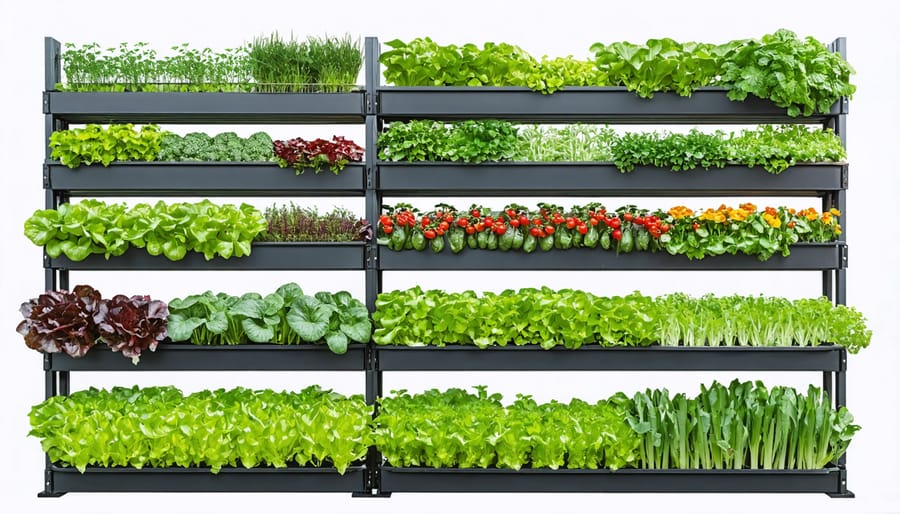
Container and Small-Space Ideas
Limited space shouldn’t prevent you from growing your own vegetables. With clever small space gardening solutions, you can create a thriving vegetable garden almost anywhere. Vertical gardening is a game-changer for compact areas – try installing trellises or wall-mounted planters for climbing vegetables like peas, beans, and cucumbers.
Container gardening offers incredible flexibility. Choose deep pots for root vegetables like carrots and potatoes, while shallow containers work perfectly for herbs and leafy greens. Self-watering containers are particularly useful for busy gardeners and help maintain consistent moisture levels.
Make the most of sunny balconies or patios with stackable planters or tiered garden systems. These clever designs maximize growing space while creating an attractive garden feature. For ultra-compact spaces, try growing microgreens or herbs in window boxes – they’re perfect for adding fresh flavors to your cooking year-round.
Don’t forget about succession planting in your containers. As soon as one crop finishes, replace it with another to keep your small space productive throughout the growing season. Mix quick-growing radishes with slower-developing plants to optimize every inch of soil.
Remember to choose compact or dwarf varieties specifically bred for container growing. These plants provide full-sized harvests while taking up minimal space, making them perfect for small-scale vegetable gardens.
Garden Planning Tools and Resources
Having the right tools at your disposal can make garden planning both enjoyable and efficient. Start with a comprehensive garden planning journal to track your garden’s progress, record planting dates, and document successes and learning opportunities throughout the seasons.
For digital planning, several user-friendly apps have revolutionized garden design. The Planter app offers customizable garden layouts and plant spacing guides, while Garden Plan Pro helps you track succession planting and crop rotation. These tools send timely reminders for planting and maintenance tasks.
Essential physical tools include graph paper for sketching layouts, plant markers, and a soil testing kit to understand your garden’s growing conditions. Consider investing in a quality measuring tape and some sturdy stakes for mapping out beds accurately.
Online resources like companion planting charts and local frost date calendars are invaluable for timing your plantings. Many agricultural extension offices provide free planning worksheets and regional planting guides specific to your growing zone.
For visualization, garden planning software like GrowVeg allows you to create detailed garden layouts and automatically calculates spacing requirements. Remember, while these tools are helpful, they should complement rather than replace hands-on observation and experience in your garden.
Planning your vegetable garden is an exciting journey that combines creativity with practical know-how. By carefully considering your space, sunlight, soil conditions, and seasonal timing, you’re already on the path to growing success. Remember that even small spaces can yield bountiful harvests when properly planned, and starting with a few easy-to-grow vegetables can build your confidence. Whether you choose raised beds, container gardening, or traditional plot layouts, the key is to start with a solid plan that matches your goals and lifestyle. Don’t be afraid to experiment and learn from each growing season – every gardener started somewhere, and your green thumb will develop with time and experience. So grab your planning tools, sketch out your dream garden, and take that first step toward growing your own fresh, nutritious vegetables at home.



